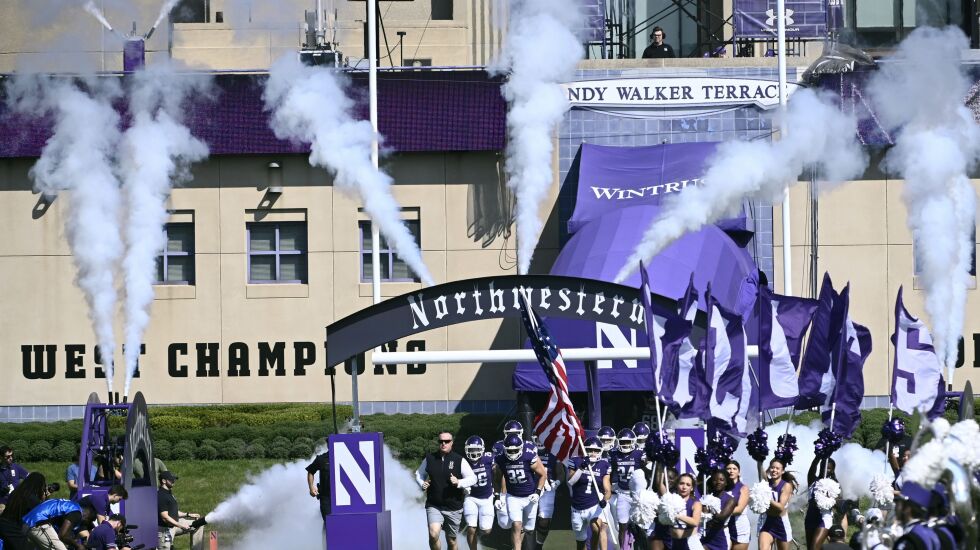
The Northwestern University hazing scandal will be the biggest in the history of college sports in terms of the sheer number of athletes involved, attorneys who filed the only two lawsuits in the case said Thursday.
Attorneys Parker Stinar and Patrick Salvi Jr. said they have heard from Northwestern athletes who describe abuse that is far worse in women’s sports than in the football program formerly run by fired head coach Pat Fitzgerald.
“We’ve heard of horrible hazing incidences that led to severe depression and mental health issues,” Salvi told the Sun-Times.
That includes an alleged “rape” of one woman athlete by another, he said. That incident “went reported and, ultimately [was] not acted upon, followed by retaliation. Unbelievable stories. Not only as it relates to the acts but … reaction to it,” Salvi told the Sun-Times.
“If the athletic department were doing what it was supposed to be doing, it would get rooted out. … People would lose their jobs. Other students would be kicked off teams. But instead, the abused would be forced to continue playing with their abusers. Continue to be coached by their abusers. And told to just ‘suck it up’ without any sort of change or other support. … The stories are vast and cover so many sports that it’s really been a shock to the system.”
Stinar added there also was “possibly sexual assault from a member of the staff onto a player. That’s the extent of what we can share.”
It was unclear Thursday if any of the alleged incidents were reported to police.

Northwestern spokesperson Jon Yates said the university “does not comment on pending litigation.”
Instead, Yates sent the same emailed statement released earlier this week, noting steps the university has announced, “including the monitoring of the football locker room, anti-hazing training and the establishment of an online reporting tool for complaints.”
Those steps “are just the start, and we will be augmenting them in the coming weeks,” the statement continued. “As President Michael Schill wrote Tuesday in a message to the Northwestern community, the University is working to ensure we have in place appropriate accountability for our athletic department.”
Stinar represented some victims in the sexual abuse case at Michigan State University that culminated in the conviction of Dr. Larry Nassar. As sports doctor for Michigan State University and USA Gymnastics, Nassar was accused of assaulting more than 150 women over two decades in an examination room on the MSU campus.
The Northwestern scandal appears to pale by comparison to that level of abuse. But in terms of the numbers of athletes involved, Stinar said, it’ll be bigger.
“What’s going on at Northwestern far exceeds that of any academic institutional case that I’ve ever seen or been involved with,” he said, mentioning not only Nassar, but also Jerry Sandusky at Penn State, George Tyndall at USC and Robert Anderson at the University of Michigan.
“Those cases were one bad actor in which a university knew or should have known about the conduct and failed to take appropriate action,” Stinar said.
“Here, we have an entire athletic department and probably university that enabled this conduct, and it wasn’t just one bad actor. So I suspect, and anticipate, as we dig deeper into this case, that the events that took place at Northwestern — and ultimately the number of claims that come forward — far exceed that of any academic institutional case that we’ve seen in the history of the United States.”

Salvi and Stinar represent two former players identified as “John Does” in the first two lawsuits filed to date against Northwestern.
They expect to ultimately represent scores of male and female athletes — not in a class action, but in what Salvi called a “mass-action.”
Typically, class-action lawsuits are filed “when the harms to the class of plaintiffs are very similar,” Salvi said. “Here, each individual suffered a different harm in different sports, different time frames, different specific incidences, different damages in terms of how it affected each individual plaintiff.”
Whatever it’s called, Northwestern may try to settle, to prevent even more embarrassing details from coming out in depositions and at trial.
But Stinar and Salvi say they have no interest in settling out of court. They’re determined to identify those they called “fixers” who believed “protecting the brand” of Northwestern University was more important than protecting the victims.
“We aren’t just here to put on a show and reach a quick settlement. We’re here to initiate change,” Stinar said. “That’s gonna require us to pull out all the skeletons from the closet. That’s what these survivors deserve. That’s what faculty and alumni deserve and the public deserves.”

After Fitzgerald’s initial suspension, the Daily Northwestern student newspaper disclosed sordid details of the alleged sexual abuse, and Schill fired Fitzgerald.
One of many unanswered questions is what role, if any, the school’s deep-pocketed donors have had in how the university has responded to the scandal.
Stinar expects those questions to be answered during the litigation, but said “everything that we’re hearing tells us that the … athletic department is led by prominent donors.”
The biggest donor, billionaire insurance magnate Pat Ryan, could not be reached for comment. His name adorns the football stadium and a host of other buildings on Northwestern’s campus. And he’s donated hundreds of millions of dollars more for a new stadium project — now in jeopardy because of the hazing scandal.







